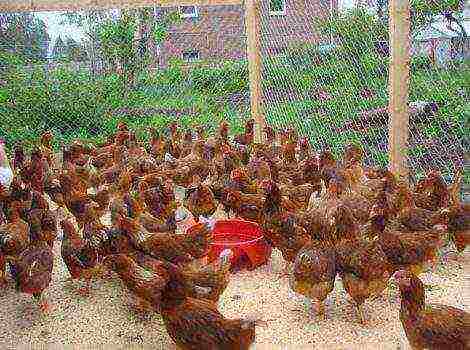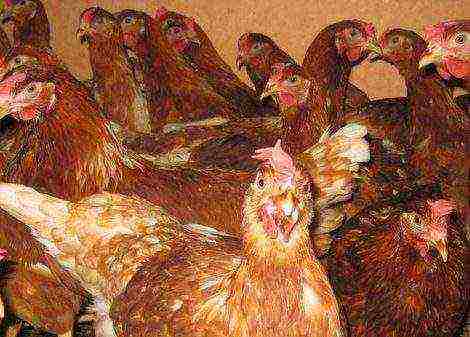How to make an egg incubator with your own hands
In this article, we will talk about what the simplest household incubator consists of and how you can do it yourself without large investments. The components of a household incubator can vary depending on whether you want to make it fully manual, semi-automatic or automatic.
You will need:
- lid with a viewing window;
- frame;
- lattice for eggs;
- light bulbs with chambers;
- capacities for water;
- fan at 12 V;
- Regulator voltage 12 V;
- thermometer;
- thermostat;
- thermal sensor;
- controller flip frequency (digital timer).
Types and sizes of incubators
What can be used to make this useful thing at home?
- from foam;
- from cardboard boxes;
- from plywood or wood;
- from the old refrigerator.
This list is not final. The specified list of different materials implies the manufacture of the cover and body from these materials. A detailed description, characteristics and device of each type of incubator can be found below.
Incubator dimensions will depend primarily on:
- number of eggsthat you will be putting.
- from location light bulbsthat heat the incubator.
For reference: with an average incubator length of 450 - 470 mm and a width of 300 - 400 mm, the capacity of eggs, pcs. (depending on size):
- chicken up to 70;
- duck or turkey up to 55;
- goose up to 40;
- quail up to 200.
Homemade foam incubator, description and drawings
You will need: sheets of polystyrene (expanded polystyrene) measuring 50 x 100 cm. Thickness - 50 mm.
We mark the sheet with a pencil and a ruler. We take arbitrary sizes. Example:
Side wall: Length - 50 cm, height -50 cm.
End wall: length - 35 cm, height - 50 cm.
Cut the foam to size with a sharp knife. If the foam is not extruded, then it is better to cut stationery knife - it is very sharp, the blade is thin.
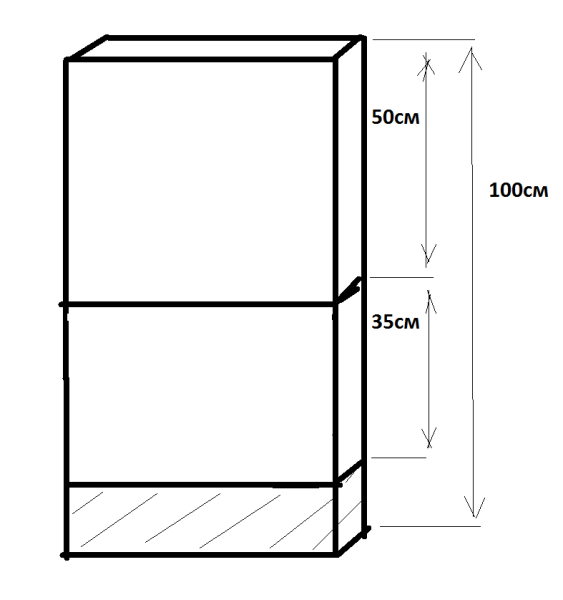
We do the same with the second sheet.
Further assembling the body in accordance with the presented drawing. This is done with rubber glue or simply wrap the joints with wide tape. Thus, we get the side, end sides and bottom of the case. At the bottom of the case, which is also cut to fit the dimensions of the walls, be sure to make 2-3 holes for air ventilation.
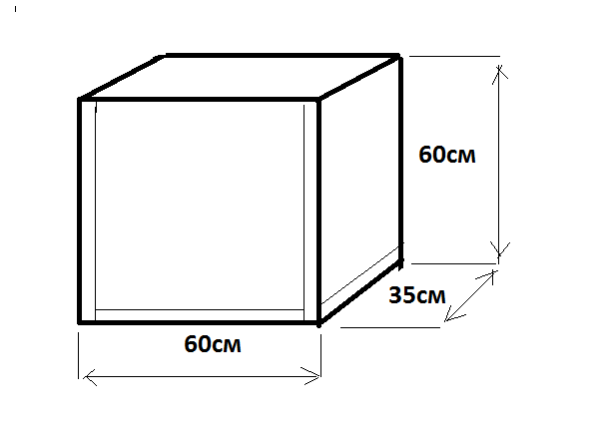
Cover we make separately with a viewing window and a pair of holes for ventilationas shown in the diagram below.
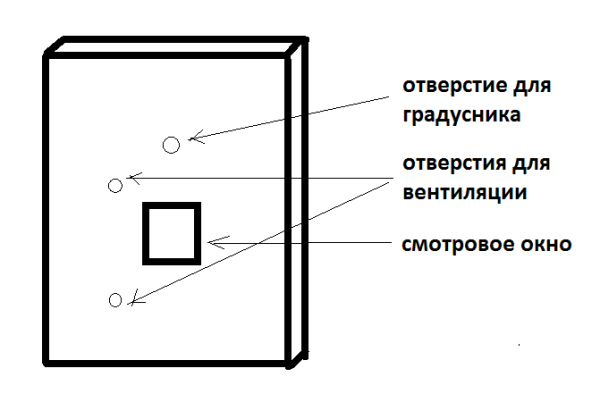
Glass "Tightly" is not necessary to fix. After the chicks appear, we adjust the temperature in the incubator by moving it back a quarter or half. The proposed design of the incubator assumes that it will be heated by three electric 25 watt bulbs, this is enough to maintain the required temperature. We must make the lid with partially cut out sides so that it does not move along the body. For this purpose, you can also glue sides... As a material, wooden blocks or foam blocks are used.
On the lid, we attach three electric chuck with bulbs.
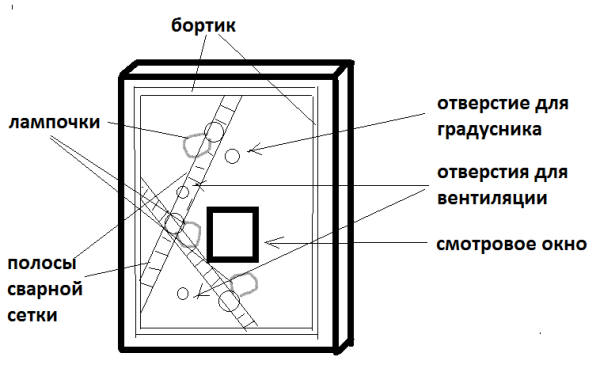
We install a thermostat on top (if the design assumes it).
The egg grate is made of welded galvanized mesh 16 x 24 mm, closed from the inside with a plastic mosquito net.The net is needed so that small chicks do not fall with their paws into the cells. In addition, they stick their heads in the cells, which ends up badly for them (and for you). We build up on the grid sides (walls), the height of which must be at least 8 - 10 cm, otherwise the chicks will jump over it. If you do not plan to roll the eggs by turning the grate along its axis, then we make the sides smaller than the grate around the entire perimeter, and the grate will cover the entire internal space of the incubator and will lie on the bars. In this design, you have to turn each egg by hand, marking them on one side with a plus (+), and on the other, respectively, with a minus (-). Come up with your own notation.
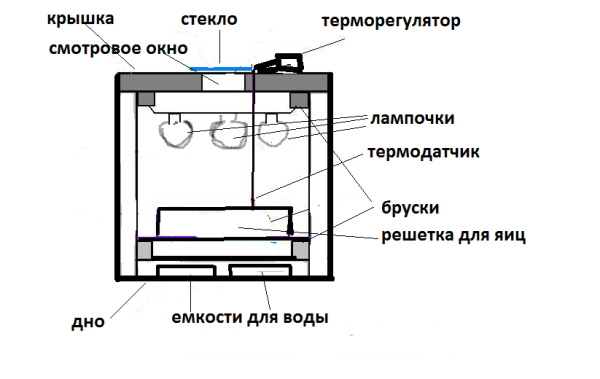
This design can be to improve, equipping it with an ordinary computer 12-volt fan, using a voltage regulator, an adapter (respectively for 12 volts) and a thermostat.
It is possible to construct an indicator with heated by bulbs, which will be located below, under the tray (lattice) with eggs. Then the design will be more compact. Its height may not exceed 25-30 cm. Bulbs and chambers for them can be taken the same as in an ordinary household refrigerator. You can use a different type of heater (film from underfloor heating systems).
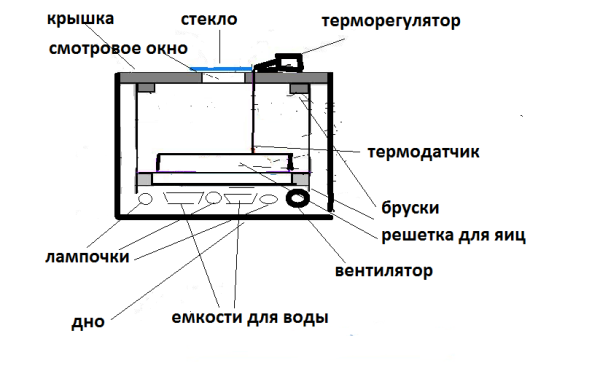
To do not turn every egg, you can put the lattice (tray) not on the bars on the bottom, but make holes closer to the bottom of the incubator, insert the bushings there, attach the lattice to the bushings with corners or other clamps. Attach handles or holders to the outside. Thus, the lattice can be rotated along its axis, changing the degree of inclination of the eggs and, accordingly, warming up one side of the eggs, then the other. In this case, the grate should be smaller in size than the inner walls of the incubator so that it can change the angle of inclination without interference. Bars of grates then they should be higher than 5 cm, because otherwise the chicks can waddle over the side and fall to the bottom of the incubator to the light bulbs and containers with water.
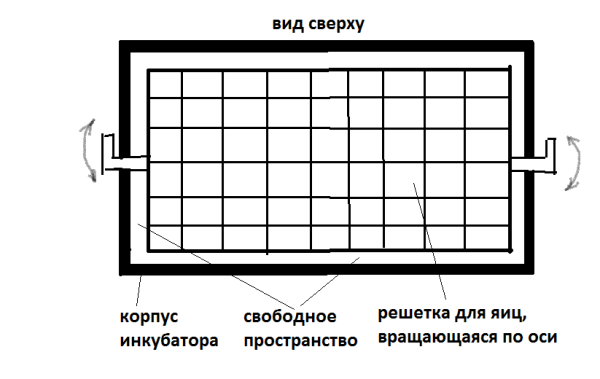
Out of a cardboard box, diagram and device
Perhaps the simplest and cheap incubator option Is a cardboard box construction. Cardboard is very inferior in strength to all other materials, so this type of incubator has certain features.
Ventilation holes are located from the bottom by 3-4 cm; on the side walls, at a distance of 6-7 cm from the bottom, we attach wooden slats to the walls. Instead of slats, you can put bars on the bottom of the box, which we cover with foil. It should be larger in size than the bottom, so that its edges go over the walls. On pallet we install any container with water.
We put the usual packaging for eggs on slats or bars. Cut a hole in the middle for better air ventilation... He makes a cover for the box with two holes: in the middle, for the lamp, and on the side for the thermometer.
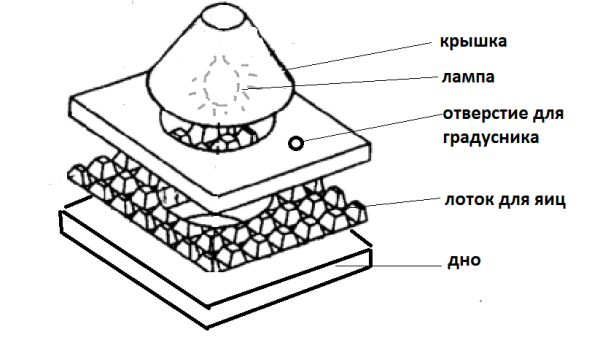
DIY plywood
If you make an incubator from this material, then it walls must be double... The top cover, as in the previous versions, is removable. A viewing window with glass is cut through it. We do ventilation holes similar to the previous options.
From the inside of the incubator, mount sockets for lamps, and below the rails for the tray are nailed. We also drill holes for ventilation in the plywood floor. There can be 4-10 of them.
Tray or lattice of eggs also suit the frame type. We put a mosquito net or a construction netting on the grate. The incubator is installed in a warm room.
From the old fridge
If your farm has old refrigerator, which you managed to replace with a new one, but the old one has not yet been thrown away, you can use it as a homemade incubator.
We throw away everything that is superfluous, including the freezer. From above are done ventilation holes... They are also made at the bottom of the incubator. Install at the bottom 12 volt fan.
Next you need to install heaters... This role is played by electrical 25 watt light bulbs... You need 4 such bulbs. Two bulbs are placed at the top of the refrigerator, and two at the bottom. At the bottom, we fix the chamber in such a way that at the bottom it is possible to place a tray with water.
Egg trays are also made from galvanized welded mesh with sides. If you choose plastic fruit crates as the material, it's also good. Then they are cut to a height of 6 cm. All trays are installed on the axle and are tied together by a bar with which the inclination of the eggs changes.
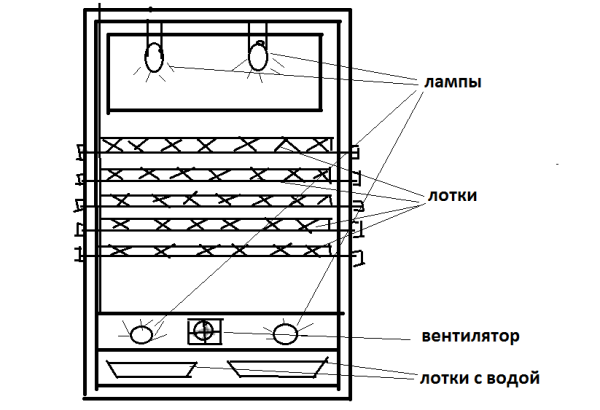
Auto
In some of the foregoing embodiments, it has been proposed that manual or semi-automatic incubator... In order to do automatic incubator, you must additionally purchase:
- block thermostat;
- tray automatic egg flippingthat turns the eggs at a specific angle;
- frequency controller coup (timer).
Differences in temperature conditions for different types of poultry
In the first two days, you need to warm up the eggs well, so the temperature in the incubator is set at 38-38.7 ° C.
Chicken eggs in the first days of incubation, they are kept at a temperature of 39 to 38 degrees, gradually lowering it. In the last days (20-21) - 37.6.
Duck - from 37.8 to 37.1 degrees to decrease.
Goose - from 38.4 to 37.4.
Turkeys - from 37.6 to 37.1.
Quail all 17 days of incubation are kept at the same temperature of 37.5 degrees.
As you can see, doing incubator at home, the material can be varied and depends on what is at hand. To guide the reader what the financial benefit will be from this event (meaning the difference between a ready-made incubator bought in a store and made by hand), we can say that at least threefold benefit... If you do not buy automation, then the difference will be even greater. Of course, what you make will have and minuses: does not look so aesthetically pleasing, perhaps not so long service life. Despite this, many prudent owners prefer make an incubatorrather than buying.
Comparing the material from which the incubator body is made, we can say that foam incubator has the lowest heat loss, out of a cardboard box - the cheapest. From what material you will make - it is up to you to decide.

